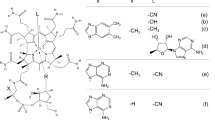Abstract
In this study, the vitamin B12 contents were analyzed in the edible portions of various shellfish (bivalves and snails). High vitamin B12 contents (30.5–53.3 μg/100 g wet weight) were detected in mussels, surf clams, bloody clams, and freshwater clams. However, scallops and abalone had extremely low vitamin B12 contents (0.1–1.1 μg/100 g wet weight) which was attributed to only the muscle portions being edible. These results suggest that high levels of vitamin B12 are accumulated in the viscera of shellfish. Vitamin B12 levels were also significantly higher in bivalves than in snails. The corrinoid compounds purified from all bivalves were identified as “true” vitamin B12 using liquid chromatography–electrospray ionization/tandem mass spectrometry. In edible snails, abalone, and pond snails, however, both vitamin B12 and pseudovitamin B12 (an inactive corrinoid) were observed to be the major and minor corrinoid compounds, respectively. Based on these results, we conclude that the whole bodies of these edible bivalves are excellent sources of vitamin B12 for humans.



Similar content being viewed by others
References
Watanabe F, Yabuta Y, Tanioka Y, Bito T (2013) Biologically active vitamin B12 compounds in foods for preventing deficiency among vegetarians and elderly subjects. J Agric Food Chem 61:6769–6775
Watanabe F (2007) Vitamin B12 sources and bioavailability. Exp Biol Med 232:1266–1274
Yoshino K, Inagawa M, Oshima M, Yokota K, Umesawa M, Endo M, Yamagishi K, Tanigawa T, Sato S, Shimamoto T, Iso H (2005) Trends in dietary intake of folate, vitamin B6, and vitamin B12 among Japanese adults in two rural communities from 1971 through 2001. J Epidemiol 15:29–37
Herbert V (1996) Vitamin B12. Present knowledge in nutrition, 7th edn. International Life Sciences Institute Press, Washington, DC
Watanabe F, Katsura H, Takenaka S, Fujita T, Abe K, Tamura Y, Nakatsuka T, Nakano Y (1999) Pseudovitamin B12 is the predominant cobamide of algal health food, spirulina tablets. J Agric Food Chem 47:4736–4741
Watanabe F, Katsura H, Takenaka S, Enomoto T, Miyamoto E, Nakatsuka T, Nakano Y (2001) Characterization of vitamin B12 compounds from edible shellfish, clam, oyster, and mussel. Int J Food Sci Nutr 52:263–268
Tanioka Y, Takenaka S, Furusho T, Yabuta Y, Nakano Y, Watanabe F (2012) Characterization of vitamin B12-related compounds isolated from edible portions of abalone. Vitamins 86:390–394 (in Japanese)
Ishihara Y, Ueta K, Bito T, Takenaka S, Yabuta Y, Watanabe F (2013) Characterization of vitamin B12 compounds from the brackish-water bivalve Corbicula japonica. Fish Sci 79:321–326
Tanioka Y, Yabuta Y, Miyamoto E, Inui H, Watanabe F (2008) Analysis of vitamin B12 in food by silica gel 60 TLC and bioautography with vitamin B12-dependent Escherichia coli 215. J Liq Chrom Rel Technol 3:1977–1985
Ministry of Education, Culture, Sports, Science and Technology (2010) Report of the subdivision of resources. In: Standard tables of food composition in Japan—2010. The Council for Science and Technology, Ministry of Education, Culture, Sports, Science and Technology, Tokyo, pp 154–158 (in Japanese)
Sugita H, Mase K, Iwata M, Kato S, Sugiura C, Ueda R, Deguchi Y (1991) Vitamin B12-producing ability of the gut microflora of marine gastropods. Suisanzoshoku 39:363–369 (in Japanese)
Ueta K, Ishihara Y, Yabuta Y, Masuda S, Watanabe F (2011) TLC-analysis of a corrinoid compound from Japanese rock oyster “Iwa-gaki” (Crassostres nippona). J Liq Chrom Rel Tecnol 34:928–935
Ueta K, Takenaka S, Yabuta Y, Watanabe F (2011) Broth from canned clams is suitable for use as an excellent source of free vitamin B12. J Agric Food Chem 59:12054–12058
Stupperich E, Nexo E (1991) Effect of the cobalt-N coordination on the cobamide recognition by the human vitamin B12 binding proteins intrinsic factor, transcobalamin, and haptocorin. Eur J Biochem 199:299–303
Shibata K, Fukuwatari T, Imai E, Hayakawa H, Watanabe F, Takimoto H, Watanabe T, Umegaki K (2013) Dietary reference intakes for Japanese 2010: water-soluble vitamins. J Nutr Sci Vitaminol 59:S67–S82
Acknowledgments
The authors thank Mr. T. Noguchi for his technical assistance. This work was supported partly by a Grant-in-Aid for Young Scientists (B) (No. 24700856) from JSPS KAKENHI (YT).
Author information
Authors and Affiliations
Corresponding author
Rights and permissions
About this article
Cite this article
Tanioka, Y., Takenaka, S., Furusho, T. et al. Identification of vitamin B12 and pseudovitamin B12 from various edible shellfish using liquid chromatography–electrospray ionization/tandem mass spectrometry. Fish Sci 80, 1065–1071 (2014). https://doi.org/10.1007/s12562-014-0787-x
Received:
Accepted:
Published:
Issue Date:
DOI: https://doi.org/10.1007/s12562-014-0787-x




